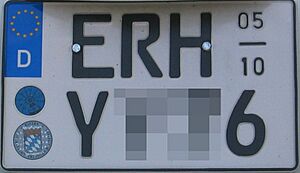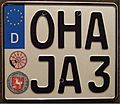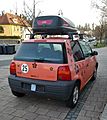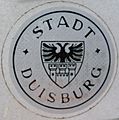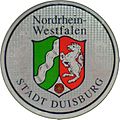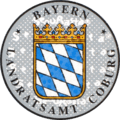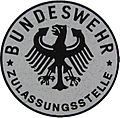German car number plates facts for kids
German car number plates (called Kfz-Kennzeichen in German) are special signs on cars that show where the car is registered in Germany. When someone moves to a new main home in Germany, or buys a new car, they need to get new number plates.
You can get number plates that work all year, or only for 2 to 11 months within any 12-month period. This is handy for people who might switch between a summer car, like a convertible, and a winter car, like a regular sedan. It saves them time and money from having to register and unregister their cars often.
Contents
What Do German Number Plates Look Like?
The number plates used since 1994 have black letters and numbers on a white background. On the far left, there's a blue strip. This strip shows the European Union flag (12 golden stars in a circle) and a white letter D for Deutschland (Germany). This tells you the car is registered in Germany and is part of the European Union.
After the blue strip, there are one to three letters. These letters tell you the city or region where the car is registered. For example, B stands for Berlin. These codes usually match the official districts in Germany. Sometimes, a city and the area around it share the same letter code. If they do, the city often has a different number of letters after the code than the surrounding area. For instance, the city of Straubing uses SR - A 123, while the nearby district of Straubing-Bogen uses SR - AB 123. This helps make sure there are enough unique combinations for all the cars.
The number of letters in the city/region code often gives a clue about the size of the place:
- The biggest German cities usually have just one letter, like B for Berlin, M for Munich, K for Cologne, and F for Frankfurt am Main.
- Most other districts in Germany have two or three letters.
Districts in eastern Germany often have more letters for a couple of reasons:
- They started using this modern system later, after German reunification in 1990. Many shorter letter combinations were already taken by cities in western Germany. So, a big eastern city like Dresden has DD (two letters) instead of just D, which was already used for Düsseldorf.
- Fewer people live in eastern Germany, so there are fewer cars registered. This means they don't need as many short codes.
This is mostly a general rule, and there are some exceptions. For example, Hamburg, Germany's second-largest city, uses HH (for Hansestadt Hamburg, meaning Hanseatic City of Hamburg, because of its history with the Hanseatic League).
The main reason for this system isn't to show how big a place is, but to make sure there are enough unique number plate combinations. A number plate can have a maximum of eight characters in total.
After the location code, you'll see stickers for vehicle tests (like safety checks). Then, there are one or two letters and one to four numbers. Car owners can sometimes choose these letters and numbers themselves, or the registration office can give them random ones. The total number of letters and numbers on a plate is never more than eight. Motorcycles often get one letter with low numbers because their plates are smaller.
Why Some Letters Are Not Allowed
Some letter combinations are not allowed on German number plates. This is mainly because they were used by groups connected to Nazi Germany. For example, the district of Sächsische Schweiz uses the code PIR (from its main town, Pirna) to avoid using SS, which refers to the Schutzstaffel, a Nazi group. Similarly, SA (for Sturmabteilung) is also avoided.
Other banned combinations include:
- HJ (for Hitlerjugend, or Hitler Youth)
- NS (for Nationalsozialismus, or National Socialism)
- KZ (for Konzentrationslager, or concentration camp)
Sometimes, mistakes happen, and a few cars might have been registered with these banned codes, like B-SS 12. Some areas might allow these combinations if they are the owner's initials (like XX-NS 1234 for Norbert Schmidt). But if that car is sold and re-registered in the same area, the number can be changed.
Special Plates for Special Cars
Certain types of vehicles have special codes on their number plates:
- Classic Cars: Old cars, known as Oldtimer in Germany, can get an H (for historisch, meaning historic) at the end of their plate, like K-AA 100H. This helps preserve these "vehicles of cultural value." To get an H-plate, a car must be at least 30 years old and mostly in its original condition.
- Seasonal Plates: Cars with seasonal number plates have two numbers at the end that show the months they are allowed to be driven (e.g., 05-10 means May to October). This saves money on registration fees and insurance.
- Official Cars: Vehicles used by the police, fire department, or local government often don't have letters after the sticker, just numbers, like M-1234.
* These include vehicles for district governments, local governments (like fire brigades), police, and disaster relief. * Since March 2007, most official vehicles now get standard number plates.
The car for the President of Germany has the number plate 0-1. The Chancellor of Germany's car has 0-2, and the Foreign Secretary's is 0-3. The President of the Bundestag (German parliament) has 1-1. This special number shows that the Bundestag President is very important, even though they are not part of the government. These special government cars don't pay taxes and don't need insurance because the German government acts as their insurer.
- List of currently issued registration codes (German Wikipedia)
- List of all ever issued registration codes of the current registration system (German Wikipedia)
Images for kids
-
A number plate with the 1-letter code Z for Zwickau.
-
A number plate with the 2-letter code TR for Trier.
-
A number plate with the 3-letter code CUX for Cuxhaven.
-
This plate from Frankfurt am Main has the letters F ST.
-
A very old example of a personalized plate from Kiel.
-
An example of a permitted combination: AC-AB.
-
An example of a damaged plate from Kronach, where the bottom seal is missing.
-
A vehicle belonging to the Baden-Württemberg state government.
-
A number plate from 1985, in the style used since 1956, from Hanover.
-
An Überlingen number plate, brought back in Bodenseekreis in 2020.
-
A sticker for FCN on a number plate (not officially allowed).
-
A number plate from Nuremberg city with two middle letters.
-
A number plate from the Nürnberger Land district with one middle letter.
-
A registration seal from the City of Duisburg, before 1994.
-
A registration seal from the City of Duisburg, North Rhine-Westphalia, after 1994.
-
A registration seal from the Coburg district, Bavaria.
-
A safety test sticker (valid until June 2007) and a registration seal from Fürth, Bavaria.
-
A vehicle from the Wasser- und Schifffahrtsverwaltung des Bundes (Federal Waterways and Shipping Administration) in Würzburg.
See also
 In Spanish: Matrículas automovilísticas de Alemania para niños
In Spanish: Matrículas automovilísticas de Alemania para niños






